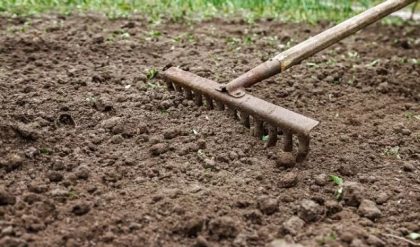Design of Shelterbelt:
A shelterbelt involves following parameters for determining under its design:
1. Location:
The location of wind break/shelter belt should be in such a way, as to dissipate the maximum amount of wind energy, and thus to control the soil erosion. In case of unidirectional blowing winds, the location of break/belt at right angles to the direction of prevailing wind is one of the most suitable location point for the wind break/shelter belt, to reduce the impact of wind velocity, better way in significant amount.
However, as per blowing direction of wind the following change can also be made in the location:
(a) If direction of prevailing wind is likely to change in the area, then a secondary break/belt can also be raised at right angles to the primary belt (i.e., the belt which has already been installed).
(b) When direction of prevailing wind does not change, but remains constant, then a series of primary breaks/belts can be raised to make the system more effective.
For location of shelter belt or wind-break in series the following points should always be taken into consideration:
i. The belt/break should be located at the distance at least 1.5 times the height of tallest tree of the break or belt from the row of tallest tree. Location at very close distance from the houses or buildings should always be avoided, because there may be developed several bad effects.
ii. The primary shelterbelt should be located along the edges of gullies, streams and -roads, whereas secondary system may be established along the boundaries of agricultural fields lying at the sides of the gullies, streams or roads.
iii. In hilly tracts the planting of trees or shrubs at cross ridges running down the valley, is more important.
Width:
It indicates the number of rows of plants, raised in the shelter belt or break. A wind break involves one or maximum two rows, but a shelter belt involves more than two rows.
The rows of plants should be raised in following trends:
(a) The row of tallest trees should be arranged in the middle of shelterbelt.
(b) Shorter trees should be raised in the sides of tallest tree’s row.
(c)The shrubs should be planted at the outer edge of belt.
The suitable plant species to be raised in first row towards wind ward side, middle rows and rows towards leeward side, have been cited in Table 7.8; they can be used for establishment of wind break or shelterbelt in a particular area of specified region.

The establishment of plant’s row in above fashion, develops a triangular profile of the shelter-belt, as shown in Fig. 7.14. However, this trend can also be modified by raising the tallest trees in front row, facing the affected area, followed by trees of decreasing height in the next successive rows. The profile of this shelter belt is in the form of right angles triangle.

The Central Arid Zone Research Institute (CAZRI), Jodhpur has reported that in the areas where wind velocity does not exceed 20 km per hour, the shelter belt may be raised by 3 to 5 rows, but in some cases even up to 7 rows can also be raised by maintaining the row spacing as 4 m.
In coastal areas, more than 20 rows of shelter bell may be established. It usually follows a rule that the width of shelterbelt or barrier should normally be 10 times of its height.
Length:
The length of shelterbelt depends on the width of area to be protected, climatic conditions etc. The shelterbelt length should always be matched with the width of area required to protect. The area of land protection gets increase with the length of the shelter belt. At the length of 24 times the tallest tree’s height, the magnitude of area protection gets increase as square of the belt length.
In this regard, Kailth and Erasmun have reported the following result, which reveals that if tree heights are kept constant (i.e. 50 ft.) and length of break is varied, then increase in area protection was 4 times, 36 times and 4.84 times, respectively for 200, 1200 and 2640 ft shelterbelt length, i.e. area of protection varies as the square of increase in length of break.

Spacing:
The spacing of shelterbelt/wind break is the horizontal distance between the points, from where protection of area from a belt begins to that point where protection of area from this belt ends. The spacing of shelter belt/break depends on the choice of plant species and degree of wind erosion to be controlled. Greater the tree’s height of the shelter belt, more will be the zone of influence on leeward side.
However, apart from above points, the spacing of belt or break should also be fixed, based on the following points:
a. Velocity of prevailing wind; and
b. Variations in the direction of prevailing winds
Experimentally, it has been obtained that the velocity of wind is influenced upto the distance of 15 to 20 times the height of tallest tree of the shelter belt towards leeward side, and about 5 times the height of shelterbelt towards windward side.
Density:
Density of shelterbelt or wind break denotes the spacing of plants in each row and spacing of rows, too. Sometimes, it is also referred as permeability of the break/belt. The density determines the effectiveness of break/belt to reduce the impact of wind velocity and also maintain a good quality of shelterbelt for better protection. The studies on this aspect indicate that the shelterbelts should be so permeable, that the wind currents may be diffused slowly, because it has been found that a solid wall even provides immediate protection, behind, but the effect disappears very soon over a short distance.
Based on density, the wind breaks/shelter belts are classified in following three types:
i. Fully Penetratable:
This type of shelterbelt includes considerably large zone of influence and reduces wind velocity by 30 to 40% of the original speed.
ii. Partially Penetratable:
The porosity of this type of shelterbelt varies from 40 to 50%. The gaps between trees are assumed to be uniform throughout the body of shelter belt. The partially penetratable shelterbelts are best for providing maximum sheltered zone, and are more effective to control the wind erosion. For establishing a partially penetratable shelterbelt the shrubs should be planted at the interval of 1 to 1.5 m and trees at 2 to 3 m in the rows.
iii. Impermeable:
This type of shelterbelts are less effective to control the wind erosion, as in this ease diffusion of wind currents is being at rapid speed. The impermeable shelterbelts act similar role on soil erosion control as the stone or brick walls.
Effectiveness of Shelterbelt Layout:
At the places, where dominant erosive wind is blowing from a single direction, then there is greater probability of soil removal by the wind currents. In this situation, the best protection is achieved by aligning the shelterbelt in parallel rows at right angles to the wind direction. But where erosive winds come from more than one directions, then grid or herringbone system of layout is used for establishing the shelterbelt.
The requirement of best layout of belt is to provide maximum control on soil erosion against blowing winds or average protection over all wind directions and all the wind velocities above threshold value. The effectiveness of shelterbelt layout can be predicted, using the equation 7.41. i.e.

Using this equation the wind erosivity is calculated first by assuming no protection, and then also estimated a value by reducing the V̅ t by the ratio as (vx/vo), in which vx is the wind velocity at the distance x from the belt, x is the height of belt and vo is the wind velocity in open field. The magnitude of (vx/vo) can be calculated by using the following relationship –

In which, H = x/sin β, where β is the acute angle of incident wind.
Effect of Shelterbelt on Wind Movement:
When wind strikes the shelterbelt perpendicularly, then it gets modified on both sides of the belt, as shown in Fig. 7.16. In this figure, two types of shelterbelts are shown, in which one is permeable shelterbelt and other is impermeable. In permeable shelter belt, a part of wind is passed out through the belt, while in impermeable belt it is deflected over the belt.

And as the wind blow is divided, there forms a zone of reduced wind, extent of which depends on the height of the structure. From field studies it has been found that the percentage reduction in wind velocity at any particular distance from a dense wind break is relatively constant.
In order to get proper reduction in wind velocity, the shelterbelt should have following characteristics:
i. It should be permeable.
ii. It should have proper width and shape.
iii. It should have a good height.
The distance up to which wind velocity gets reduce from the belt is normally expressed in terms of multiple of shelter- belt height (H).
Effect of Permeability on Wind Movement:
An impermeable shelterbelt does not reduce the wind velocity in large extent, while a partially permeable belt results considerable reduction and also covers a greater distance on downstream side. From wind tunnel studies, it has been obtained that about 35% permeability is optimum for shelterbelt. However, the main principle of shelterbelt is that it should be in narrow thickness with moderate density.
In order to have a proper effect on wind velocity reduction, it is important that the shelterbelt should be composed of nearly uniform vegetation density from top to the bottom. A continuous gap should be avoided in the shelterbelt, because this gap can neutralize the effect of large section of shelterbelt, due to wind tunneling effect through the gap. If the shelterbelt has to be crossed by the roads, paths and irrigation ditches, then a diagonal opening should be made to reduce the tunneling effect.
Effect of Width and Shape of Shelterbelt:
Deciding the shape of shelterbelt for reduction of wind speed, is more important than its thickness, i.e., width has secondary consideration. Normally, a narrow shelterbelt of moderate density is most effective, than the broad ones. The width of a shelterbelt is decided on the basis of area of the land, which is to be used for controlling the wind erosion. In non-irrigated areas, five rows shelterbelts are generally preferred, as they are economical to establish and maintain.
Some shelterbelts are also raised for multi-purpose, for example to provide fuel, fodder, shelter for bees, cover for wildlife etc. For these purposes, more than five rows shelterbelts may be raised. In arid zones where rainfall is not heavy and sufficient irrigation is required for plants growth, only one row or maximum three rows belts may be developed. However, single row shelterbelt is risky, because if holes are developed there, then aim of shelterbelt may not be fulfilled.
The shape of shelterbelt affects the wind velocity on its leeward side. A shelterbelt having vertical side, provides greater wind reduction for wider leeward area, than the inclined shelterbelt, due to the reason that the inclined shelterbelt deflects most of the wind upward. The effects of shape of shelterbelt on wind reduction is shown in Fig. 7.15.

Effect of Height:
The height of break/belt pronounces a great effect on wind velocity reduction or length of protection. From field experiments, it has been reported that the velocity of wind is reduced up to the distance of 15 to 20 H towards leeward side (H is the height of tallest tree) and up to 5 h towards wind ward side (h is the height of break/belt). It is shown in Fig. 7.17. The major zone of protection at leeward side plus the smaller protected zone towards windward side, is the total area, protected by the shelterbelt.

General Purpose of Establishing Shelterbelt:
The type and structure of shelterbelts (i.e., shape, thickness and width) mainly depend on the purpose for which they are to be used.
These are normally established for following purposes:
i. They are raised for protecting the agricultural lands and range lands against wind erosion or wind effect.
ii. Established to provide shelter for livestock.
iii. For protecting the farm steads.
iv. They are also raised for checking sand movement from the area.
v. Shelterbelts play a great role for providing the shelter to the wild lives.
Planting Techniques:
1. Selection of Plant Species:
For selection of the plant species, whether they are indigenous or exotic, the choice should be such that they are fast growing. Preferably, the trees or shrubs should be evergreen or they develop a good foliage during the periods of high wind velocity and precipitation. Some common species of trees and shrubs are listed in the Table 7.7. The zone-wise suitable species for establishment of shelterbelt/wind break are also cited in Table, 7.8.


In general, the selection of species for establishing the wind break/shelterbelt depends on following parameters:
i. Edaphic and climatic conditions of the area
ii. Growth rate
iii. Wind protection properties
iv. Ease of establishment, and
v. Serving as barrier to wind and always as the source of fuel/fodder/timber.
The local species, which can be easily established are also suitable for shelterbelts development. Local species should be given preference for this purpose.
Mainly, the following characteristics should always be taken into consideration for selecting the species:
i. Exotic species should never be given preference, unless they have been tested for their effectiveness.
ii. The species should be fast-growing.
iii. Non-exacting to moisture and wind resistant.
iv. Have dense crown and low branching characteristics.
v. Should be resistant to drought and nonbrowsable.
vi. Can develop proper porosity in the shelter belt.
vii. Should have inherent ability to withstand against damaging winds, and also have high degree of foliage development.
viii. The species should be evergreen and deciduous mixture to have better protection from the wind, throughout the year.
ix. The tallest trees should have strong and large crown to check the wind effect.
Nursery Techniques:
Seedling stock is required for planting the trees or shrubs for establishment of shelterbelt. They should be raised in properly managed nurseries. There are some specific nursery techniques, suitable for each locality and species. They should be followed properly. Germination test is essential to ensure the use of viable seeds, because sowing of poor quality seeds is wastage of money as well as effort and more importantly the entire season may be lost. Similarly, poor seedlings (weak plants) should not be used for planting. They are risky for establishing the shelterbelt.
Soil Preparation for Planting:
Preparation of planting site is more important for development of shelterbelt as compared to the conventional forest. A shelterbelt for its successful establishment requires high seedling survival, so that early growth of plants and their development in tree form can be obtained easily in time. All these are totally based on good soil preparation. Normally, the preparation of soil for the depth of 40 to 60 cm in the entire planning strip is found better.
When there exists hard layers or naturally impermeable hard pans in the soil, then depth of ploughing should be such that it can break such layers. For plantation, individual holes should be dug either mechanically or by hand. The depth of hole should be such that it can accommodate the seedling without curling the roots. Also, the holes should be made along the irrigation ditches or channels.
After Care of Planting:
Care of plants regarding supply of irrigation etc. for establishing the shelterbelt in proper way is very essential. Irrigation should be done regularly, because irrigation of plantings is essentially required on dry sites. Temporary irrigation is needed during establishment to ensure success and uniformity in plants growth. A uniform plant growth assures good quality of the shelterbelt.
Large gaps if there, should be removed by replanting with those plants which have fast growth. Weeds should also be removed from the site. Defoliators or pests should be controlled time to time, otherwise, they will reduce the development of vegetative foliage. Since, the main purpose of shelterbelt is to provide protection, so pruning as well as thinning of plants should not be clone, as they adversely affect the density and continuity of vegetative layer. In addition, a strict protection against grazing, browsing, illegal cutting and fire, is also most essential.




Comments are closed.